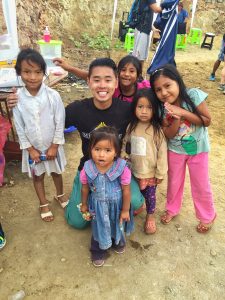Students set up health care clinics abroad
While many opportunities exist for medical students to gain experience in their field at USC, one organization active in Latin America and Africa has opened its doors to the entire student body.

Photo courtesy of Oscar Chen
Going global · USC Medlife President Oscar Chen traveled to Peru in January to deliver healthcare services and educate local people.
USC Medlife sends students abroad to provide healthcare to the local residents in developing countries. Members of the organization have attended mobile clinics in Lima, Peru and Riobamba, Ecuador this past year. This winter, the organization will conduct its first clinic in Managua, Nicaragua, according to USC Medlife President Oscar Chen.
In an email to the Daily Trojan, Chen said that Medlife’s mission is driven by its belief in the universal nature of healthcare.
“Medlife is dedicated to providing care to medically underserved communities because it is morally wrong to deny any individual to access to healthcare,” Chen wrote.
According to Chen, students who participate in the trip assist in setting up mobile clinics in the local communities and shadow different stations, including triage, doctor, dentist, OB/GYN, tooth brushing and pharmacy. They also educate the community about disease prevention, including lessons on how to administer self-examinations for breast lumps that could potentially lead to breast cancer.
Students of any year or major can join Medlife by submitting an application online. After attending their first trip, students become members of the USC chapter. Each trip with Medlife lasts from one to two weeks, and each mobile clinic lasts one week. On average, approximately 20 to 25 USC students participate in each trip, joining students from other universities to create a total staff of 60 to 100 students.
All the expenses for Medlife trips are covered by participation fees and donations. Students are required to pay a participation fee that ranges from between $600 to $800 depending on the location of the trip, which includes housing, food, transportation for a week and the equipment and staff needed.
Local healthcare professionals assist Medlife with each trip. According to Chen, these health professionals work in a hospital for 10 to 11 months during the year, and volunteer for one or two months at the mobile clinics. He believes that along with the help of the local healthcare providers, the cultural barrier between visiting students and local people can be decreased, as they can relate to the community and communicate with the patients in the local language.
“This is a very important aspect of Medlife because these health professionals have a greater understanding of the sociopolitical factors that contribute to inadequate healthcare in the communities that they serve,” Chen wrote. “The healthcare professionals that we work with also speak English, so students are encouraged to ask questions and learn from their experiences.”
Medlife has also created development projects that focus on bringing sustainable changes to the local community. Students involve themselves in construction while they are abroad, and help fundraise for specific projects when they return from the trip.
“One of the biggest issues with organizations that help these impoverished communities is what happens when they leave due to limited resources,” Chen wrote. “Are the communities able to adopt a healthier lifestyle or will they revert back to their original state? Medlife creates sustainable projects like staircases and water delivery systems that have lasting impacts on the community.”
Claire Justin, a junior majoring in non-governmental organizations and social change and global health, joined Medlife to gain a better understanding of how medicine is practiced in an underserved population in a low-income country. She said that her first trip to Peru in the winter of 2015 allowed her to feel more closely connected with her global health goals.
“Not only did I get to see and participate in the wonderful humanitarian work that Medlife is doing in Peru, [but] I also learned about the specific challenges that the working poor in Peru face,” Justin said. “Being in Peru opened my eyes to the realities that people in low-income countries face when it comes to trying to get health care. The whole experience showed me that the global community can have a real and lasting impact on their lives.”
Medlife focuses on providing healthcare not only to those in developing countries but also to the local community. According to Chen, when students are not volunteering in mobile clinics, they have opportunities to serve the underserved people around the city of Los Angeles.
“One of the key philosophies of Medlife is that we aim to provide care to people that suffer from inadequate access,” Chen wrote. “This included volunteering abroad in third world countries but also in the United States itself. We shape our members into active members in the fight against healthcare disparities in the hopes of improving the lives of countless people around the world.”
Kathleen Tor, a senior majoring in biological sciences, said that the trip gave her insight to the delivery of healthcare outside of the United States.
“Medlife has definitely changed the way I view the world,” Tor said. “I have since developed a new appreciation for things I had previously taken for granted, such as clean water and access to health care facilities. Medlife opened my eyes to global issues with which I had not previously concerned myself.”
